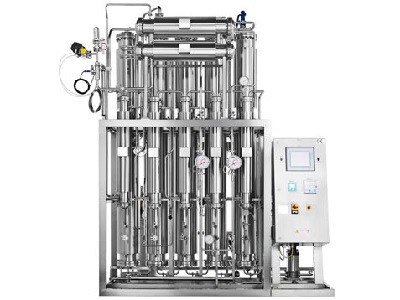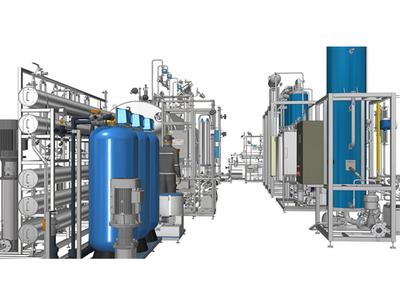Pharmaceutical reverse osmosis systems utilize membrane separation technology, which is currently the most advanced and energy-efficient membrane separation equipment. The principle involves increasing the osmotic pressure beyond the solute concentration in water, preventing other substances from passing through the reverse osmosis (RO) membrane while separating these substances from the water.
The ultrafiltration membrane used in RO plant for pharmaceutical industry has a very small pore size (around 10 nm), which can effectively remove dissolved salts, colloidal solutions, microorganisms, and organic compounds from water, achieving a removal rate of up to 97-98%. Large and medium-sized pharmaceutical reverse osmosis systems offer excellent water quality, high efficiency, zero pollution, simple construction, and ease of use.
In the pharmaceutical industry, pure water must meet specific key indicators such as resistivity, cation composition, etc. These indicators include a resistivity of no more than 2 μS/cm, heavy metal residue of less than 0.3 μg/L, and a TOC of no more than 500 μg/L. To meet these water quality standards, common wastewater treatment processes include: (RO reverse osmosis + mixed bed), double-stage reverse osmosis, and (RO reverse osmosis + electrodialysis).
Large and medium-sized pharmaceutical reverse osmosis systems use RO membranes to separate contaminants from source water, collecting pure water in the process. No changes occur during this process, and no strong acid or alkali wastewater is produced. Because of its energy efficiency and environmentally friendly advantages, the RO membrane method has become one of the primary methods for producing pure water in the pharmaceutical industry.
Biocell's pharmaceutical reverse osmosis systems are efficient and advanced water treatment solutions designed specifically for pharmaceutical applications. The system centers around reverse osmosis (RO) membrane separation technology and achieves precise operation through fully automated control. Its integrated design and modular installation features simplify the installation process, reduce energy consumption, and minimize space usage, making it ideal for the pharmaceutical industry's strict space and energy efficiency requirements.
In terms of water production, Biocell uses a dual-pipeline supply with a single-pipeline circulation design. This configuration not only improves water production efficiency but also helps effectively control microbial growth, ensuring the quality and safety of pharmaceutical water.
Regarding the control system, Biocell's pharmaceutical reverse osmosis system is equipped with anti-mistake settings and audit trail functions, ensuring permanent data retention and preventing modification, which meets the pharmaceutical industry's high standards for data integrity and traceability. The electrical control system is well-organized, with a strong and weak electrical separation design to guarantee the safe and stable operation of the system.
Additionally, the system is equipped with a user-friendly touch screen, instruments, and valves, enhancing the user experience by making operation and monitoring extremely convenient.


